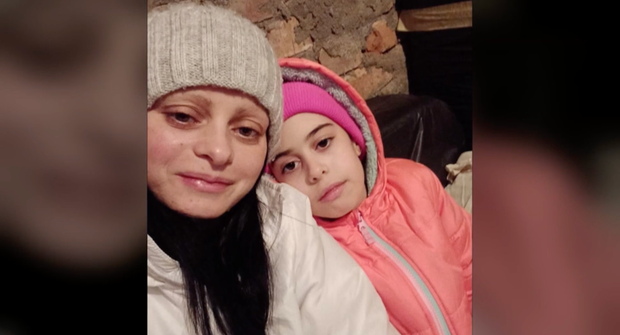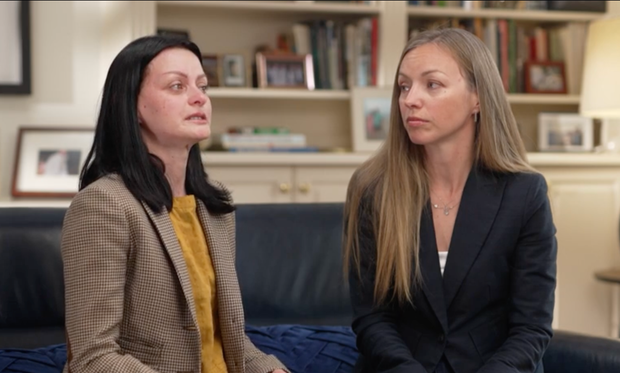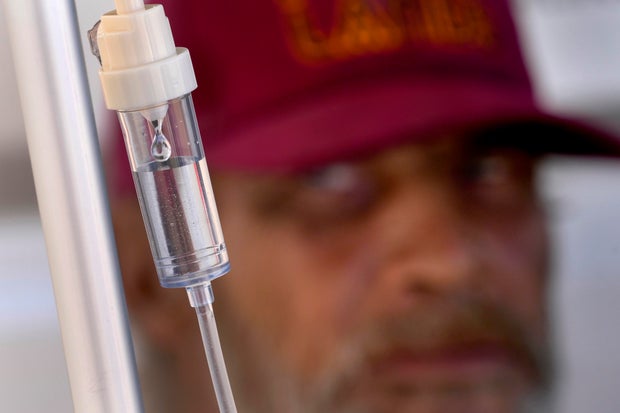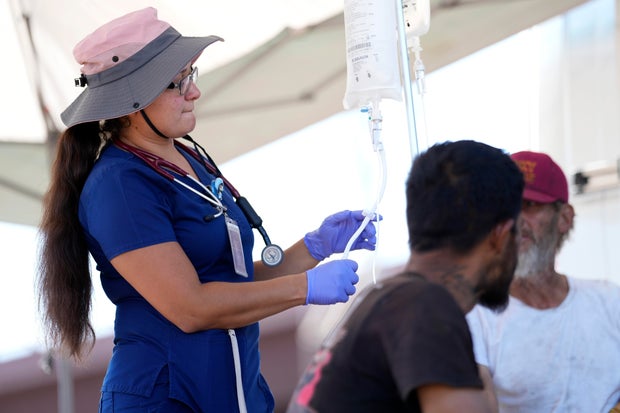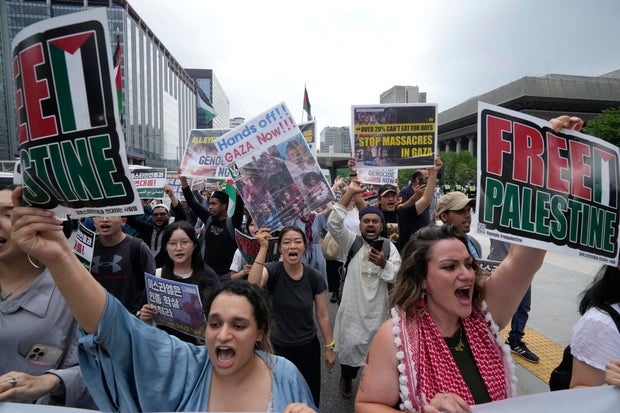CBS News
In 2 years since Russia’s invasion, a U.S. program has resettled 187,000 Ukrainians with little controversy
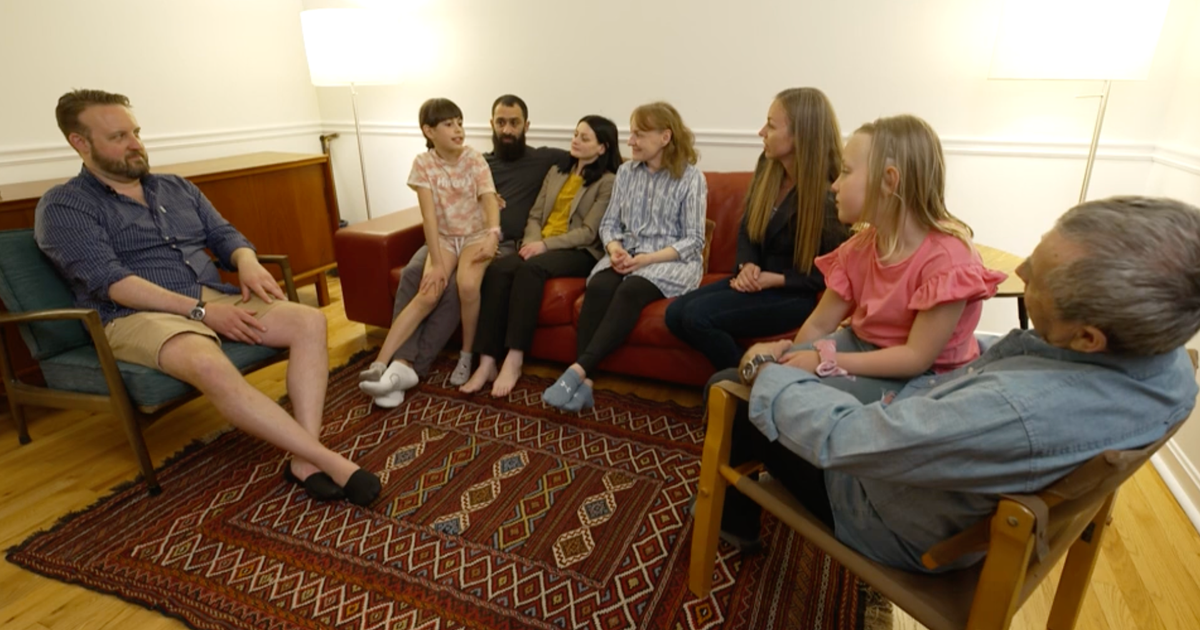
Pennington, New Jersey — Yana, a 10-year-old fourth-grader from Ukraine with a bright smile and big dreams, said she has felt welcomed in New Jersey, calling the U.S. “very, very, very nice.”
“I like the flowers here,” Yana said in English, which she has learned remarkably quickly. “People aren’t, like, being mean to anybody. They’re being nice to everybody.”
Asked if she feels safe in America, Yana said, “Yeah.”
Roughly two years ago, Yana and her family had their lives suddenly upended by Russia’s invasion of their native country. Olena Kopchak, Yana’s mother, remembers the very moment their neighborhood in the port city of Mykolaiv was shelled by the Russian military.
“We heard powerful explosions,” Kopchak said in her native tongue. “We could not believe it at the beginning … our house was literally moving. It started to shake. We thought it was the end.”
Courtesy of Olena Kopchak
Russia’s invasion in February 2022 displaced millions of refugees, most of them women and children, triggering the largest refugee exodus in Europe since World War II. As other European countries like Poland and Germany absorbed these refugees, the U.S. quickly followed suit, with President Biden vowing to welcome 100,000 Ukrainians.
In April 2022, the Biden administration created an unprecedented program known as “Uniting for Ukraine,” allowing an unlimited number of Ukrainians sponsored by Americans to come to the U.S. and work here legally without having to go through the lengthy visa process.
“I didn’t sleep on that night when the program was launched. I was sitting at midnight waiting for the website to open,” said Lana Rogers, Kopchak’s sister and an American citizen living in New Jersey.
Rogers used the Uniting for Ukraine program to sponsor her sister and her family, who arrived in New Jersey in June 2022. While they initially lived with Rogers and used government aid for basic necessities, Kopchak and her husband have since found jobs and their own apartment in central New Jersey.
CBS News
In two years, U.S. immigration officials have approved more than 236,000 cases under the Uniting for Ukraine program, according to the Department of Homeland Security. As of the end of March, more than 187,000 Ukrainians had arrived in the U.S. under the policy.
Another 350,000 Ukrainians have arrived in the U.S. outside of the sponsorship process since the start of the Russian invasion, mainly through temporary visas, according to DHS.
“The Department has delivered on President Biden’s commitment to welcome Ukrainians fleeing Russia’s premeditated and unprovoked war on Ukraine,” Homeland Security Secretary Alejandro Mayorkas said in a statement.
Unlike most U.S. immigration policies, the resettlement of tens of thousands of Ukrainian refugees in American communities has occurred with resounding efficiency and relatively little controversy.
Republican-led states, for example, have filed lawsuits against virtually every major Biden administration immigration policy, including a similar sponsorship program for migrants from Cuba, Haiti, Nicaragua and Venezuela. But the Uniting for Ukraine program has not been challenged in court. In fact, some Republican lawmakers have expressed support for welcoming Ukrainian refugees.
While the arrival of hundreds of thousands of migrants at the U.S.-Mexico border has strained resources in some communities like New York City, Chicago and Denver, the resettlement of Ukrainians has not provoked the same backlash, nor triggered major political problems for the Biden administration.
Unlike the program for Cubans, Haitians, Nicaraguans and Venezuelans, which is capped at 30,000 approvals per month, Uniting for Ukraine has no numerical limit. Applications for the Uniting for Ukraine program are also adjudicated fairly quickly, sometimes in a matter of weeks or even days — a rarity in a backlogged and understaffed U.S. immigration system.
Krish O’Mara Vignarajah, president and CEO of the refugee resettlement organization Global Refuge, said Uniting for Ukraine “shows how the U.S. can act with swiftness when it wants to.”
Vignarajah said geopolitics is partially behind the warm reception in the U.S. for Ukrainian arrivals, who are seen as victims of an anti-American government in Moscow. “There’s certainly a sense of solidarity between the American and Ukrainian people,” she said.
Another reason Ukrainian refugees have enjoyed a smoother transition in the U.S. than some new arrivals, Vignarajah argued, is the unique nature of Uniting for Ukraine.
Those who come to the U.S. under Uniting for Ukraine need an American sponsor willing to help them financially, and they can work legally immediately after setting foot on U.S. soil. Congress also made the first wave of Ukrainian refugees eligible for refugee resettlement benefits, such as food stamps.
Migrants coming from the southern border can’t work legally until 180 days after they request asylum. They’re also generally not eligible for federal benefits. Cubans, Haitians, Nicaraguan and Venezuelans who arrive under the other sponsor policy have to apply for a work permit before they can work legally.
Vignarajah said race may also be playing a role in how Ukrainians have been welcomed, compared to other immigrant populations. “Just as racism and xenophobia have penetrated so many elements of our society, it did factor into the unique treatment that Ukrainians received,” she said.
Still, Ukrainians face their own obstacles. Their permission to be in the U.S. under an immigration authority known as humanitarian parole expires every two years, and they lack a path to permanent legal status or American citizenship.
While the Biden administration has argued that most Ukrainians will eventually go home once the war in their homeland ends, there’s no sign that will happen anytime soon.
“I [cannot] come back,” Kopchak said in English, noting her hometown of Mykolaiv continues to be bombed by the Russians. “I not have no house. I not have nothing.”
Costanza Maio contributed to this report.
CBS News
Street medics treat heat illnesses among homeless people as temperatures rise

Alfred Handley leaned back in his wheelchair alongside a major Phoenix freeway as a street medicine team helped him get rehydrated with an intravenous saline solution dripping from a bag hanging on a pole.
Cars whooshed by under the blazing 96-degree morning sun as the 59-year-old homeless man with a nearly toothless smile got the help he needed through a new program run by the nonprofit Circle the City.
“It’s a lot better than going to the hospital,” Handley said of the team that provides health care to homeless people. He’s been treated poorly at traditional clinics and hospitals, he said, more than six years after being struck by a car while he sat on a wall, leaving him in a wheelchair.
Circle the City, a non-profit that works in multiple cities and hospitals and treats about 9,000 people annually, introduced its IV rehydration program as a way to protect homeless people in Phoenix from life-threatening heat illness as temperatures regularly hit the triple-digits in America’s hottest metro.
Matt York / AP
Homeless people accounted for nearly half of the record 645 heat-related deaths last year in Maricopa County, which encompasses metro Phoenix. As summers grow warmer, health providers from San Diego to New York are being challenged to better protect homeless patients.
Dr. Liz Frye, vice chair of the Street Medicine Institute which provides training to hundreds of healthcare teams worldwide, said she didn’t know of groups other than Circle the City administering IVs on the street. The organization also distributes tens of thousands of water bottles each summer and tries to educate people about hot weather dangers.
“But if that’s what needs to happen to keep somebody from dying, I’m all about it,” Frye said.
Bringing care to people in need
The amount of people requiring treatment for heat illnesses is rising. The Boston Health Care for the Homeless Program, featured in last year’s book, “Rough Sleepers,” now sees patients with mild heat exhaustion in the summer after decades of treating people with frostbite and hypothermia during the winter, said Dr. Dave Munson, the street team’s medical director.
“It’s certainly something to worry about,” said Munson, noting that temperatures in Boston hit 100 degrees with 70% humidity during June’s heat wave. Homeless people, he said, are vulnerable to very hot and very cold weather not only because they live outside, but they often can’t regulate body temperature due to medication for mental illness or high blood pressure, or because of street substance use.
The Phoenix team searches for patients in homeless encampments in dry riverbeds, sweltering alleys and along the canals that bring water to the Phoenix area. About 15% are dehydrated enough for a saline drip.
Matt York / AP
“We go out every day and find them,” said nurse practitioner Perla Puebla. “We do their wound care, medication refills for diabetes, antibiotics, high blood pressure.”
Puebla’s street team ran across Handley and 36-year-old Phoenix native Phillip Enriquez near an overpass in an area frequented by homeless people because it’s near a facility offering free meals. Across the road was an encampment of tents and lean-tos along a chain-link fence.
Enriquez sat on a patch of dirt as Puebla started a drip for him. She also gave him a prescription for antibiotics and a referral to a dentist for his dental infection.
Living outside in Arizona’s broiling sun is hard, especially for people who may be mentally ill or use sedating drugs like fentanyl that make them less aware of their surroundings. Stimulants like methamphetamine contribute to dehydration, which can be fatal. Dr. Matt Essary, who works with Circle in the City’s mobile clinics, said the organization also often treats surface burns that can happen when a medical emergency or intoxication causes someone to fall on a sizzling sidewalk.
Matt York / AP
Temperatures this year have reached 115 degrees in metro Phoenix, where six heat-related deaths have been confirmed through June 22. Another 111 are under investigation, and the city is seeing an “increasing” number of patients with heat illnesses every year, according to Dr. Aneesh Narang, the assistant medical director of emergency medicine at Banner Medical Center-Phoenix, which treats many homeless people with heat stroke.
Narang’s staff works frequently with Circle the City, whose core mission is providing respite care, with 100 beds for homeless people not well enough to return to the streets after a hospital stay.
Extreme heat worldwide requires a dramatic response, said physician assistant Lindsay Fox, who cares for homeless people in Albuquerque, New Mexico, through an initiative run by the University of New Mexico’s School of Medicine.
Three times weekly, Fox treats infections, cleans wounds and manages chronic conditions in consultation with hospital colleagues. She said the prospect of more heat illness worries her.
Highs in Albuquerque can hit the 90s and don’t fall enough for people living outside to cool off overnight, she said.
“If you’re in an urban area that’s primarily concrete, you’re retaining heat,” she said. “We’re seeing heat exposure that very quickly could go to heat stroke.”
Serious heat stroke is far more common in metro Phoenix, where Circle the City is now among scores of health programs for the homeless in cities like New York, San Diego and Spokane, Washington.
Circle the City works with medical staff in seven Phoenix hospitals to help homeless patients get after-care when they no longer need hospitalization. It also staffs two outpatient clinics for follow-up.
Rachel Belgrade waited outside Circle the City’s retrofitted truck with her black-and-white puppy, Bo, for Essary to write a prescription for the blood pressure medicine she lost when a man stole her bicycle. She accepted two bottles of water to cool off as the morning heat rose.
“They make all of this easier,” said Belgrade, a Native American from the Gila River tribe. “They don’t give you a hard time.”
CBS News
Hamas appears to clear way for possible cease-fire deal with Israel after reportedly dropping key demand
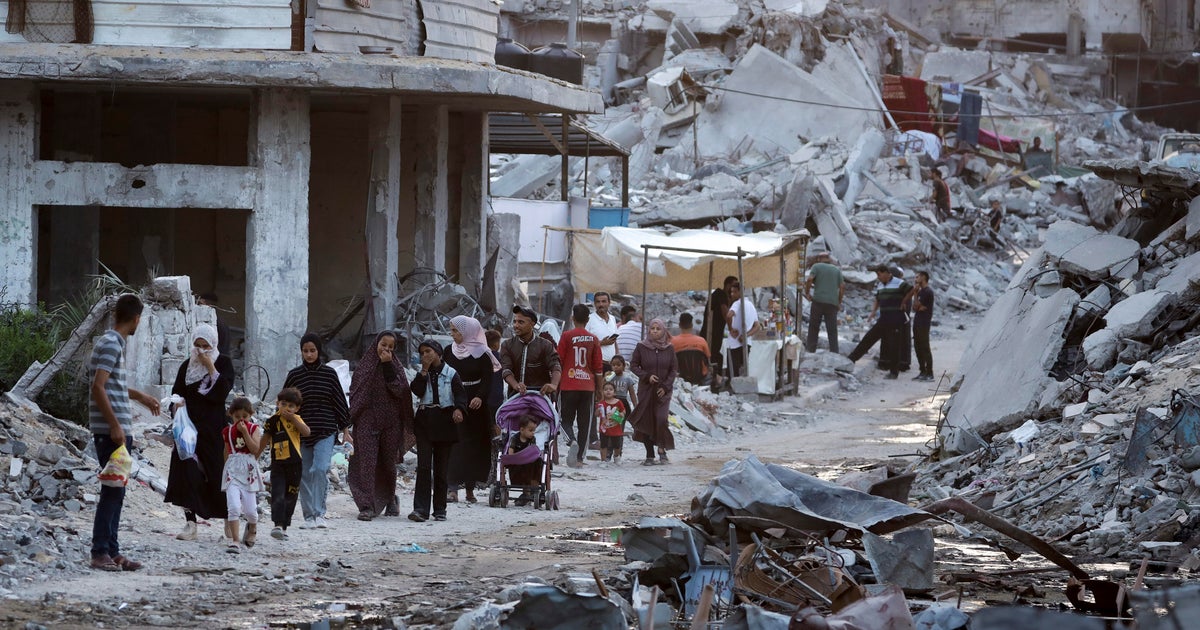
There is new hope for a cease-fire deal in the Middle East after Hamas responded to a U.S.-backed proposal for a phased deal in Gaza.
The militant group – which controlled Gaza before triggering the war with an Oct. 7 attack on Israel – has reportedly given initial approval of the cease-fire deal after dropping a key demand that Israel give an up-front commitment for a complete end to the war, a Hamas and an Egyptian official told the Associated Press on Saturday.
A senior U.S. official says that Hamas’ response to the proposal “may provide the basis for closing the deal.”
The apparent compromise could deliver the first pause in fighting since November and set the stage for further talks on ending the devastating nine months of fighting. But all sides cautioned that a deal is still not guaranteed.
The two officials, who spoke on condition of anonymity to discuss ongoing negotiations, told the Associated Press that Washington’s phased deal would first include a “full and complete” six-week cease-fire that would see the release of a number of hostages, including women, older people and the wounded, in exchange for the release of hundreds of Palestinian prisoners. During the 42 days, Israeli forces would withdraw from densely populated areas of Gaza and allow the return of displaced people to their homes in northern Gaza, the officials said.
Over that period, Hamas, Israel and mediators would negotiate the terms of the second phase that could see the release of the remaining male hostages, both civilians and soldiers, the officials said. In return, Israel would free additional Palestinian prisoners and detainees. The third phase would see the return of any remaining hostages, including bodies of dead captives, and the start of a years-long reconstruction project.
Ahn Young-joon / AP
Hamas still wants “written guarantees” from mediators that Israel will continue to negotiate a permanent cease-fire deal once the first phase goes into effect, the officials said.
The Hamas representative told The Associated Press the group’s approval came after it received “verbal commitments and guarantees” from the mediators that the war won’t be resumed and that negotiations will continue until a permanent cease-fire is reached.
“Now we want these guarantees on paper,” he said.
In line with previous proposals, the deal would see around 600 trucks of humanitarian aid entering Gaza daily — including 50 fuel trucks — with half of them bound for the hard-hit northern of the enclave, the two officials said. Following Israel’s assault on the southernmost city of Rafah, aid supplies entering Gaza have been reduced to a trickle.
Israel launched the war in Gaza after Hamas’ October attack in which militants stormed into southern Israel, killed some 1,200 people — mostly civilians — and abducted about 250. Israel says Hamas is still holding about 120 hostages — about a third of them now thought to be dead.
Since then, the Israeli air and ground offensive has killed more than 38,000 people in Gaza, according to the Hamas-run Health Ministry, which does not distinguish between combatants and civilians in its count. The offensive has caused widespread devastation and a humanitarian crisis that has left hundreds of thousands of people on the brink of famine, according to international officials.
Months of on-again off-again cease-fire talks have stumbled over Hamas’ demand that any deal include a complete end to the war. Prime Minister Benjamin Netanyahu has offered to pause the fighting but not end it until Israel reaches its goals of destroying Hamas’ military and governing capabilities and returning all hostages held by the militant group.
Netanyahu’s office did not respond to requests for comment, and there was no immediate comment from Washington.
CBS News previously reported that an Israel delegation headed by Mossad Director David Barnea was traveling to Qatar for talks. Sources told CBS News that Barnea was set to meet with Qatari Prime Minister Sheikh Mohammed bin Abdulrahman Al Thani for discussions.
On Friday, the Israeli prime minister confirmed that the spy agency’s chief had paid a lightning visit to Qatar, a key mediator. But his office said “gaps between the parties” remained.
President Biden held a 30-minute call with Netanyahu on Thursday, a senior Biden administration official told reporters, during which the two leaders walked through the latest draft of the proposal.
U.S. officials have said the latest proposal has new language that was proposed to Egypt and Qatar on Saturday and addresses indirect negotiations that are set to commence during the first phase of the three-phase deal that Mr. Biden laid out in a May 31 speech.
Hamas has expressed concern Israel will restart the war after the hostages are released. Israeli officials have said they are worried Hamas will draw out the talks and the initial cease-fire indefinitely, without releasing all the hostages.
Netanyahu is under pressure from Israel’s closest ally – the United States – to negotiate a ceasefire, but at home, two far-right wing members of his cabinet have threatened to bring down the governing coalition if he agrees to a truce.
Israel bombardment continues
The Hamas-run Interior Ministry said four police officers were killed in an Israeli airstrike Saturday in Rafah, the AP reported. The ministry, which oversees civilian police, said the officers were killed during foot patrol securing properties. It said eight other police officers were wounded. Israel’s military did not immediately respond to questions.
In Deir al-Balah, prayers were held for 12 Palestinians, including five children and two women, killed in three separate strikes in central Gaza on Friday and Saturday, according to hospital officials. The bodies were taken to al-Aqsa Martyrs Hospital, where AP journalists counted them.
Two of those killed in a strike that hit the Mughazi refugee camp Friday were employees with the United Nations agency for Palestinian refugees, the organization’s director of communications told the AP. Juliette Touma said a total of 194 workers with the agency have been killed since October.
Jehad Alshrafi / AP
Earlier this week, an Israeli evacuation order in the southern city of Khan Younis and the surrounding areas affected about 250,000 Palestinians. Many headed to an Israeli-declared “safe zone” centered on the Muwasi coastal area or Deir al-Balah.
Ground fighting has raged in Gaza City’s Shijaiyah neighborhood for the past two weeks, forcing tens of thousands of people to flee their homes. Many have sheltered in the Yarmouk Sports Stadium, one of the strip’s largest soccer arenas.
CBS News
Watch owned by Theodore Roosevelt recovered decades after theft

Watch CBS News
Be the first to know
Get browser notifications for breaking news, live events, and exclusive reporting.


